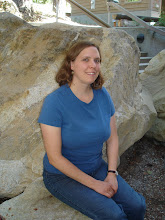The next day we went out and poked around under the owl tree. I found two owl pellets, which I picked up and kept safe until the kids were old enough to appreciate the activity. This week it was time: time to get them out and see what was inside. What had this owl eaten? Gabriel already knew what an owl pellet was, but we needed to explain to Annika that an owl can't digest the fur and bones of its prey, so it regurgitates those pieces in oval-shaped packets, or pellets. We can pick those pellets apart and look at the bones to see what the owl's meal was.

Preparation. The kids thought they wanted to use latex gloves to do the dissection, but the gloves were too unwieldy.

We found two skulls among the bug droppings.
One of our pellets had been discovered by bugs who had eaten all the fur and left only bones covered in bug droppings. That actually made it easier to dissect it. The one still covered in fur took quite awhile to pick apart. Both the kids were interested in this activity. Gabriel actually knew some of the bones, and we had a sheet we had gotten online that helped us identify most of what we found. We're not sure exactly what we had; we narrowed it down to some kind of rodent. There were two skulls and lots of tiny bones between the two pellets. Now I'm wishing I had picked up more pellets for our research.

When we were done we had a pile of fur and a plate full of tiny bones.

Lower jaw bone, pelvic bone, and two vertebrae.

Tibia and fibula.

Rodent skull and teeth. Notice the large eye sockets.
The owl did not appear last summer in the owl tree. We hope it will come back again, but if it doesn't we have fond memories of waiting for it on a summer evening and figuring out what it ate.
We paired this activity with a lovely book called The Barn Owls by Tony Johnston, illustrated by Deborah Kogan Ray. It is written in poem form, sometimes rhyming, sometimes rhythmic, but either way fun to read. My favorite page goes:
"Where owls hunted,
spiders spun
to hold the barn
to earth.
Where owls hunted,
long snakes sunned
and split their skins
like chaff
and left.
And bees hummed
their hymn
of wheat."
The illustrations are done in watercolor and watercolor pencil. The colors are saturated and mellow, golden and deep. The whole book makes me wish we lived next to a field with a hundred-year-old barn that is home to barn owls. But at least we can have a thin thread of connection to one through our owl pellet findings.






3 comments:
So interesting. I love hearing about your homeschool adventures; it makes me so excited for when I can do projects with my little one. I've already wish listed lots of the books you've talked about.
I'm glad my little blog is helpful to you! I'll continue to do book reviews, since I've gotten some good feedback already.
Thanks for sharing the contents of the owl pellet with photos and words. I got to experience the dissection too! (p.s. I followed the link to your blog from NW Hikers where you made a comment about my hike on the Hoh River)
Post a Comment